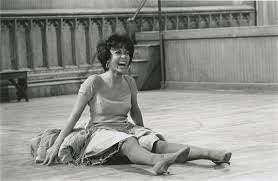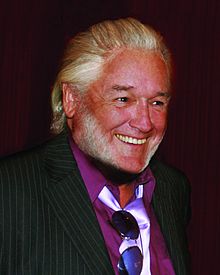TIMELESS TALE FOR A NEW GENERATION
TIMELESS TALE FOR A NEW GENERATION
Norman Warwick is excited by The Hollywood Reporter.
I have been fortunate to sit in some pretty major press conferences in the arts world, at record launches and live performances and somehow it has always felt exciting and a privilege to be there. I can only imagine how great it would have felt to be at Stephen Spielberg´s unveiling of his new renovation of West Side Story.

Attending on behalf of The Hollywood Reporter though, was David Rooney (left) , Chief Film Critic at the journal and formerly published in Variety and The New York and LA Times. His opinions make exciting reading.
What a unique kick watching Steven Spielberg introduce the New York premiere of his spectacular West Side Story remake at Jazz at Lincoln Center, on the southernmost of the 20 blocks where the story’s 1950s turf war between rival street gangs the Jets and the Sharks takes place. Even more so when cinematographer Janusz Kaminski´s graceful camera, after gliding, swooping and soaring over the rubble of a sprawling demolition site, closes in on a sign declaring the area “Property Purchased by New York City for Slum Clearance,” with an artist’s rendering of Lincoln Center for the Performing Arts, which is under construction there.
The image of a wrecking ball in that opening sequence is loaded with significance, swiftly conveying the relentless cycle of displacement and gentrification inextricably woven into the history of New York City. It turns back the clock on the Upper West Side to a specific moment in time when two distinct low-income groups were being shoved out of the transitioning neighbourhood, their shared erasure paradoxically fuelling their reciprocal hatred.

In his third collaboration with Spielberg, following Munich and Lincoln, Tony Kushner (right) has adapted the material with a respectful avoidance of cultural stereotypes and a trenchant depiction of the sadly still timely scourge of racial intolerance.

The production is equal parts grit and gloss. The expert period recreation of Adam Stockhausen’s production design and Paul Tazewell’s fabulous costumes create a throbbing sense of place, evident in every gorgeously composed widescreen frame of Kaminski’s visuals. Yet the saturated colours and their radiant glow often recall vintage Technicolor movie musicals. Perhaps those pretty CG-enhanced skies that are such a part of the Spielberg (left) and Amblin signature could have been toned down a notch. But there’s no pain in surrendering to the sheer beauty and high style of a big-screen entertainment that’s both a re-imagining informed by contemporary values and a lavishly mounted throwback.
The new West Side Story won’t take the place of the glorious 1961 screen version, co-directed by Robert Wise and Jerome Robbins, whose dances remain untouchable. But with its more inclusive, ethnically appropriate and youthful casting, this is an emotionally charged and deeply affecting retelling of a timeless tale for a new generation.

It carries added emotional heft coming just days after the death of lyricist Stephen Sondheim (right) , the last surviving member of an unsurpassed creative team that included director-choreographer Robbins, who hatched the original concept, book writer Arthur Laurents and composer Leonard Bernstein, whose score remains one of the most thrilling in musical-theatre history.
That score, by the way, has seldom sounded better. From the jagged, percussive syncopation of the gang numbers to the transporting romance of the love songs and the agitato drive of the underscoring, the music has been given impeccable treatment by the New York Philharmonic under the baton of conductor Gustavo Dudamel. David Newman did the dynamic new arrangements, while Jeanine Tesori (who co-wrote Caroline or Change with Kushner) supervised the exquisite vocals.
Spielberg and Kushner clearly have great love not just for the 1957 stage musical but also for the Wise-Robbins film, winner of 10 Oscars including best picture. There’s never any hint of this version attempting to render its predecessor obsolete. More often, it pays reverential homage to the 1961 film. That’s evident — just to name two of the more obvious instances — in the readily acknowledged debt to Robbins’ iconic dance moves in Justin Peck’s exhilarating choreography and in the creation of a customized central role for the wonderful Rita Moreno, the earlier film’s Anita.
The mixed feelings of some Latino audiences toward a group of white men depicting a Puerto Rican community will likely remain, though the principal characters on the Sharks side of the racial divide — Anita (Ariana DeBose), Bernardo (David Alvarez), Maria (Rachel Zegler) and her would-be suitor Chino (Josh Andrés Rivera) — certainly are more fully developed here.

Regardless of the sensitivity with which Kushner and Spielberg approach issues of race, class and cultural identity, the musical remains a product of its time. But if we’re going to reject West Side Story on grounds of cultural appropriation, we might also note that the source material, Shakespeare’s (left) Romeo And Juliet depicting a feud between two Verona families, was the work of an English playwright who almost certainly never travelled to Italy.
The casting of the Jets — descendants of white European immigrants led by hotheaded Riff (Mike Faist), who looks up to former gang member Tony (Ansel Elgort) and makes determined efforts to bring him back into the fold — also pushes for authenticity.
Kushner has worked in economical references to illustrate that this ragtag band of guys from predominantly Irish, Polish and Italian families have a history of hostility toward the latest arrivals, starting with the Egyptians in the early ‘50s — even before the area became known as “San Juan Hill.”
The racist euphemism of “urban renewal” carries a bitter sting. One of the strengths of Kushner’s adaptation is the way he amplifies this tragedy of prejudice and xenophobia by pointing up that the cauldron of hate is fed by schisms within the same marginalized group. The second-generation European immigrants may joke about their sorry lot in the satirical number “Gee, Officer Krupke,” but the seeds of white entitlement are already evident in their sense of blamelessness. And patrolman Krupke (Brian d’Arcy James) answers to the openly bigoted Lt. Schrank (Corey Stoll), who has more sympathy for the Jets than the Sharks, but also reminds them that their families are losers who haven’t had the good sense to move on. “The last of the can’t-make-it Caucasians,” he calls them.
All that carefully drawn social texture puts the story of star-crossed lovers in direct conversation with issues still dividing the country to this day, without ever slipping into didacticism. And the casting of younger actors turns up the flame on the romance, both in the dizzying instantaneous spell of love at first sight and the lacerating pain of loss.
Spielberg from the start conveys the extent to which the Jets feel they own the streets, their dancing taking its cues from Robbins with floating balletic moves that burst spontaneously into Peck’s more vigorous formations. Arming themselves with stolen cans of paint and paintbrushes, they deface a Puerto Rican flag mural, immediately drawing the Sharks in a clash, its visceral violence captured in Kaminski’s astonishingly mobile camerawork. The fights here are definitely fights, not fight ballets.
When Schrank orders the Sharks to disperse, they sing their version of the Puerto Rican anthem “La Borinqueña,” reaffirming their roots in the island territory while also staking their own defiant claim on the Manhattan streets.
Fired up from the conflict, Riff says it’s time for a rumble, insisting that Tony join them. But having spent a year in prison for almost killing an Egyptian immigrant in a fight, Tony has had time for self-reflection and doesn’t like what he saw. He works at Doc’s Drugstore, now run by the late proprietor’s widow, Valentina (Moreno), a doting maternal figure to Tony, who lives out back of the store. But Tony inadvertently adds fuel to the fire when he and Maria lock eyes during “The Dance at the Gym,” making her protective older brother Bernardo see red.
With a couple of exceptions like “Gee, Officer Krupke,” Spielberg and Kushner have reordered the musical numbers according to the stage version, not the previous film. That adds to the propulsion of the story, heightening the heartbreak as romantic rapture gets dragged back down to earth by violence, sending the characters hurtling toward the tragic conclusion.
The physical settings are breath-taking, paramount among them the busy streets, with cars honking and pedestrians nervously ducking out of the way as the cocky gang members strut their way through the “Jet Song.” The same streets crackle with vitality in “America,” with Anita leading the women as they claim their place in a new life about which their boyfriends remain ambivalent, their high spirits gradually drawing in the entire community. The back alleys between apartment blocks, festooned with colorful laundry, lend a magical effect to the love songs, “Maria” and “Tonight,” with Tony scrambling up the fire escape with uncontainable boyish excitement in the latter.
Kaminski gets a bit crazy with the rainbow lighting pouring through stained glass windows, but setting “One Hand, One Heart” at the Cloisters, when Tony takes Maria way uptown for an afternoon, adds a religious solemnity to their vows while also subtly linking the story back to the medieval setting of Romeo and Juliet. Ingenious touches like that make this new West Side Story even more of a love letter to New York City.
The movie’s two biggest set pieces combine visual flair with urgent dramatic impact, revealing Spielberg in masterful command of physical action through his refined sense of space and composition. This might be his first musical, but it feels like he’s been making them his entire career. “The Dance at the Gym” is a knockout, with Bernstein’s warring motifs of mambo and jazz squaring off while Peck marshals the dancers into electrifying face-offs; and “The Rumble” takes place in a warehouse used to store salt for when the streets ice up in winter, like an indoor quarry, with Kaminski’s use of overhead shots producing chilling effects to match the cacophonous danger of the music.
The placement of Maria’s winsome “I Feel Pretty” (famously one of Sondheim’s least favorite of his own songs) remains slightly awkward, following two deaths of which she’s still blissfully unaware at that point. But the idea of setting it among the clothing displays of Gimbels department store, where the Puerto Rican women work the night shift as cleaners, is enchanting.
Other songs take on a different tone, notably “Cool,” reworked as a challenge in which Tony warns Riff to stop the violence, while Riff turns on his friend, interpreting his cautionary words as disloyalty and severing their “womb to tomb” bond.

The most radical switch is giving the song of yearning for a place of peace and belonging, “Somewhere,” to Valentina, a Puerto Rican who married a “gringo” and wants only to see harmony in the world. Rita Moreno sings it alone in the drugstore, with the hushed tones of a prayer, creating a lovely echo with Tony’s song from earlier, “Something’s Coming,” in which he delights Valentina with his dream of a better life. Moreno’s contribution to the film, and her function as a living bridge from the earlier version, can’t be overstated; her customary emotional generosity and natural warmth light up her every moment onscreen.
Like Richard Beymer opposite Natalie Wood in the 1961 movie, Elgort is a tad bland, which perhaps has something to do with the character’s earnest naivety. But he sings with confidence and certainly looks the handsome part. As Maria, Zegler is a truly captivating discovery, with a delicacy that makes her appear to be floating on air — an impression deepened by her lilting soprano. Her wounded rage in the film’s finale cuts through the character’s sweetness with crushing force.
Standouts in the supporting cast include Faist, whose Riff is a smart-mouth, sinewy beanpole bristling with wiry energy; Alvarez (all grown up since his days as one of Broadway’s original Billy Elliot stars), bringing fierce pride and natural leadership to Bernardo; and DeBose, who practically jumps off the screen with commanding sensuality as Anita, a whirling, skirt-tossing tornado in her dance numbers but also a level-headed voice of reason, ready to shoot down Bernardo’s macho aggression with a well-chosen word or two and a withering glance. Watching Anita appear to age before our eyes as she absorbs devastating news is a moment of piercing sorrow.
Kushner’s mindfulness of contemporary sensibilities generally is seamless. It’s most notable in his rewriting of Anybodys, the wannabe Jet always hovering around the perimeter of their huddles, dismissed as a freak because she’s a girl who doesn’t conform to the standard norms. Here, Anybodys (Iris Menas) appears not as a tomboy in the old-fashioned sense, but a decisively non-binary character who rejects being categorized as a girl. The hovering presence remains the same, but Anybodys makes the virtual invisibility of gender nonconformity an asset, vigilantly observing and reporting back from the enemy camp.
While the film runs an ample two-and-a-half hours, editors Michael Kahn and Sarah Broshar keep things humming with surging forward motion to match the limber ensemble, allowing for appropriate breathing room in more intimate moments. While many wondered about Spielberg’s chutzpah in tackling a movie musical widely regarded as an ageless classic, his richly satisfying remake gives this version a resplendent life of its own.

I am willing to plead a case for George Best (left) being the greatest dancer the world has ever seen. However, I can honestly say that as a former non-dancing trustee of the revenue funded Can´t Dance Can, (formerly Spiraldance) in Rochdale, an avid armchair fan of Strictly, reviewer of the incredible Mazdance festivals here on Lanzarote, a lover of Cabaret and Singing In The Rain and keeper of a romanticised notion of Mr. Bojangles I cannot wait for West Side Story to be shown here on Lanzarote.
We really hadn´t expected the film to make it here to Lanzarote so quickly. Less than a month after its release we ordered our tickets on line, set off at 4.00 pm for the 5.25 showing thirty miles way in our capital city. There was a small knot of people waiting for the doors to open when we got there, but as they were allowed through by the lady checking covid passports etc they dispersed mainly into the five other salons showing other films. Only five young teenagers took comfortable seats in Salon 4, and we two pensionistas, to settle down for a West Side Story. The huge screen and the incredible sound system made it an even more exciting experience than the our cinema experience of the earlier version and any of the tv re-screenings we have all seen so many times now, and one of which I had caught only the previous night on a BBC channel.
That original showed these ´gang-members´ as being sharply dressed and socially aspirant and this Spielberg version perhaps portrays them as equally tight communities but perhaps costume, make up and lighting shows the male protagonists in particular more clearly as socially deprived. Gang society, and new immigrant experience is a subject that has been reflected in the arts almost throughout history, from the Montagues and Capulets to the Gangs Of New York and The Hatfields and McCoys but this production captured perhaps better tha any reminded us how quickly arguments become fights and fights become death. Heavy subject matter for a musical, but the singing and dancing is sublime and clearly reveals the prides and petty prejudices and hopes and fears of the lead characters. Technological developments in cinematography and lighting help show more clearly the vastness of the still tightly confining slum clearance areas of the time.
The cast is wonderful.
Ansel Elgort as Tony captures his star-crossed lover perfectly, portraying love at first sight and the complications and confusion that causes in his life and social standing and the dangers it represents to both him and the girl of his dreams, Brian Dárcy James plays Officer Krupke as a frustrated but perhaps sympathetic law officer and Croey Stoll is a suspicious, alert but slightly scared seeming Lieutenant Schrank and Dee spoke highly of Mike Faist as Riff, and Chino, who is played to ampify and illustrate showed the character´s metaporphosis from a slightly geeky and quiet guy into a confused and jealous killer.
Of the female characters, Anita is beautifully played by Anana Debose at once brightly and determinedly happy and reduced to heartbreak by circumstances beyond her female control and Rita Moreno, this time playing Valentino, gives a haunting performance that reminded me strongly of the way Billie Whitelaw delivered the twins´mother in the film The Krays, (another gangland film, albeit of a criminal fraternity).
Rachel Zegler is stunningly beautiful as Maria and her superb musical performance is matched by the acting skills that create a fully dimensional character.
Mr- Spielberg has really only painted over a few patches the original film that have not withstood the ravages of time and he has renovated them with the lightest of touch. His love for West Side Story in particular, and film musicals in general, is transparent in the refreshed vibrancy of the dance scenes. There may even be one further clue to Spielberg´s love of the genre,…or maybe I imagined it.
In a scene where members of the Sharks and The Jets are dance-racing through the streets they attract the attention of several drivers on the two lane main street, who should really have had their eyes on the road. A female passenger in one of the cars we see, leans idly on the sill of her open car window, slowly lowers her sunglasses, peers over the rim at the cavorting and gives then gang-members a look of boredom, disdain and disapproval. She might have been one of The Pink Ladies,….perhaps even Stockard Channing herself playing Betty Rizzo. I´´ ´m not sure, because it all happened very quickly, but I thought we were seeing a freeze frame homage to Grease, that was, arguably of course the most successful and popular film musical released between the two editions of West Side Story
Nevertheless, This is not a Rice and Lloyd Webber musical in that the songs don´t really drive the narrative, though of course they never feel as if they have been inserted for effect. In fact, it is very strange how West Side Story, in both its film adaptations, avoids the stop start of so many musicals before it that showed characters simply breaking off from the plot to deliver a sing-along dance number. here, in West Side Story it somehow works that the gangs skip and twirl down the streets rather than rampage through them.
The songs are slightly more episodic, perhaps, but the song Maria is delivered by Elgori as Tony as if he is aware and awed at what a life changing moment is his meeting of Maria. Her rendition of I Feel Pretty is fun and light and airy but Rachel Zegler perfectly captures her surprise and delight in feeling this way, and she offers a glimpse of the validation this new love seems to bring her.

I grew up with the PJ Proby (right) version of Somewhere (There´s A Place For Us) and as a mid-teenager with a growing love of lyrics I thought of it as a power-ballad talking about how two young people in love would find their way in the world. Of course I now realise that Spielberg, and Bernstein and Sondheim before him, are addressing those lyrics and sentiments to not only Maria and Tony but also to whole histories of emigrants and evicted and refugees of the past and the boat people of today who brave the storms of the ocean in search of safe haven.
Mr. Spielberg has paid all due reverence to the original West Side Story and yet has taken some daring moves, too. His film certainly will serve as a lasting legacy for Stephen Sondheim´s lyrics and musicality.
It is a testimony to a film that is, after all, ´only´ a re-make that we subsequently discussed at great length its merits during a subsequent first visit to the Kenewa restaurant in its elevated location overlooking the beautifully lit and buzzing area of Charcos San Gines. It showed how much we had been drawn in to look again at a West Side Story we though we knew so well.
As Dee devoured what was a beautifully presented and, she said, delicious salmon dish and I ate three enticing beef samosas with a wonderful sauce, all washed down with two glasses of wine and three (non-alcoholic) beers we treid to understand, or justify, the violence the film portrayed (slightly more graphically) than did the original.
I forced myself to have a brownie with carrot ice-cream and raspberry sauce which we followed with an Americano and Capucinno coffee.

We were two English people, with what sounded like German people at the table next to us. being served typical Japanese food on a small Spanish island that makes all of us feel welcome.
We had just watched a film about Peurto Rican emigrants feeling pretty unwelcome in a country that has, inscribed on its welcoming representation of Liberty, the words Give me your tired, your poor, Your huddled masses yearning to breathe free, The wretched refuse of your teeming shore.
It’s a mixed up, muddle up, shook up world isn´t it?

The primary source for this article was a piece written by David Rooney and published in The Hollywood Reporter
In our occasional re-postings Sidetracks And Detours are confident that we are not only sharing with our readers excellent articles written by experts but are also pointing to informed and informative sites readers will re-visit time and again. Of course, we feel sure our readers will also return to our daily not-for-profit blog knowing that we seek to provide core original material whilst sometimes spotlighting the best pieces from elsewhere, as we engage with genres and practitioners along all the sidetracks & detours we take.
This article was collated by Norman Warwick, a weekly columnist with Lanzarote Information and owner and editor of this daily blog at Sidetracks And Detours.
Norman has also been a long serving broadcaster, co-presenting the weekly all across the arts programme on Crescent Community Radio for many years with Steve, and his own show on Sherwood Community Radio. He has been a regular guest on BBC Radio Manchester, BBC Radio Lancashire, BBC Radio Merseyside and BBC Radio 4.
As a published author and poet he was a founder member of Lendanear Music, with Colin Lever and Just Poets with Pam McKee, Touchstones Creative Writing Group (where he was creative writing facilitator for a number of years) with Val Chadwick and all across the arts with Robin Parker.
From Monday to Friday, you will find a daily post here at Sidetracks And Detours and, should you be looking for good reading, over the weekend you can visit our massive but easy to navigate archives of over 500 articles.

e mail logo The purpose of this daily not-for-profit blog is to deliver news, previews, interviews and reviews from all across the arts to die-hard fans and non- traditional audiences around the world. We are therefore always delighted to receive your own articles here at Sidetracks And Detours. So if you have a favourite artist, event, or venue that you would like to tell us more about just drop a Word document attachment to me at normanwarwick55@gmail.com with a couple of appropriate photographs in a zip folder if you wish. Beiung a not-for-profit organisation we unfortunately cannot pay you but we will always fully attribute any pieces we publish. You therefore might also. like to include a brief autobiography and photograph of yourself in your submission. We look forward to hearing from you.
Sidetracks And Detours is seeking to join the synergy of organisations that support the arts of whatever genre. We are therefore grateful to all those share information to reach as wide and diverse an audience as possible.
correspondents Michael Higgins
Steve Bewick
Gary Heywood Everett
Steve Cooke
Susana Fondon
Graham Marshall
Peter Pearson
Hot Biscuits Jazz Radio www.fc-radio.co.uk
AllMusic https://www.allmusic.com
feedspot https://www.feedspot.com/?_src=folder
Jazz In Reading https://www.jazzinreading.com
Jazziz https://www.jazziz.com
Ribble Valley Jazz & Blues https://rvjazzandblues.co.uk
Rob Adams Music That´s Going Places
Lanzarote Information https://lanzaroteinformation.co.uk
all across the arts www.allacrossthearts.co.uk
Rochdale Music Society rochdalemusicsociety.org
Lendanear www.lendanearmusic
Agenda Cultura Lanzarote
Larry Yaskiel – writer
The Lanzarote Art Gallery https://lanzaroteartgallery.com
Goodreads https://www.goodreads.
groundup music HOME | GroundUP Music
Maverick https://maverick-country.com
Joni Mitchell newsletter
passenger newsletter
paste mail ins
sheku kanneh mason newsletter
songfacts en.wikipedia.org/wiki/SongFacts




Leave a Reply
Want to join the discussion?Feel free to contribute!